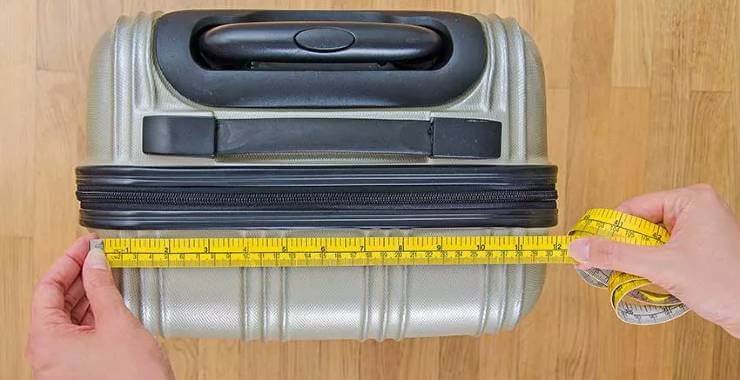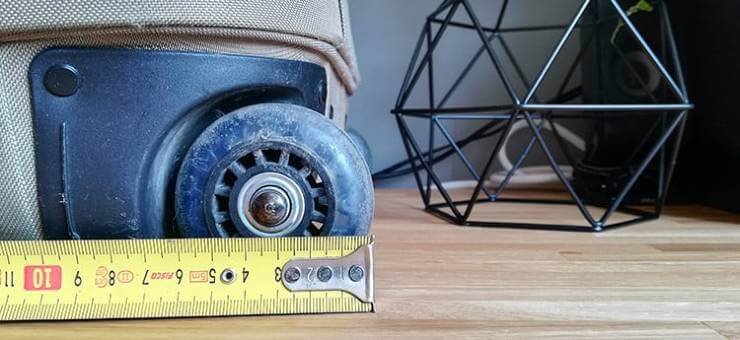Last Updated: April 26, 2022
Traveling by plane with a suitcase comes with many tedious things to do and remember before you take off. Measuring your luggage is a necessary, if not boring, aspect of the packing process. But you have to do it to ensure you avoid excess charges.
To abide by the airline’s weight and dimension requirements, you’re going to need a measuring implement and a scale.
You have to get the dimensions of the suitcase that includes the length, width, height and total weight. While you don’t have to be accurate, you want to get as close an estimate as possible.
How to Measure Luggage for Airlines
It’s easy to overlook the importance of measuring luggage, especially when you want to travel via an airplane. Every airline has their own standards and requirements for luggage weight and size.
So, you will have to check with the airline to see what these are before you attempt checking in a huge honkin’ case. The main thing to keep in mind is that your goal should be to measure the suitcase’s widest and longest points.
Tips & Tricks for Measuring

Not abiding by these requirements will result in paying some hefty fees before they even allow you to board the plane. Consider the following guidelines when measuring your luggage:
- Either call the airline or visit their website and find out what their requirements are. Don’t go to 3rd party websites, go to the airline itself. This is because airlines are always updating and changing these restrictions.
- It may seem strange, but pack your suitcase as if you were going to the airport. This will be particularly poignant if your suitcase expands when stuffed. You want to ensure you measure it in full.
- With a tape measure or yardstick, measure the entire height of the suitcase, from top to bottom. Include handles, wheels and any other parts.
- Then measure the entire width of the suitcase from side to side. Include handles or any other parts that stick out.
- You also want to measure the front to back of the suitcase, otherwise known as the depth. This will be especially important if you’re going to use the expandability of the suitcase. This means including the pockets and any other pieces that protrude from it.
- Then there’s the matter of calculating the linear inches. While there’s more on this below, it’s important to keep in mind that you’ll want to take your length, width and depth measurements and add them together.
- In the event that you’re over the weight and size restrictions, either pay the extra fees or reduce what you pack.
Measuring Luggage Size at Home
Always first measure your luggage at home. Doing this before you leave will help you comply with airline restrictions. It will also give a point of reference for traveling to additional destinations.
Choosing a Measuring Tool
Of course, going with a standard tape measure will give you accurate readings. However, there are other methods you can use if you have to be resourceful.
Trusty Tape Measure

A classic tape measure or one used for sewing will work beautifully. This gives you the most control while providing an accurate measurement. But, you can use a large ruler or yardstick as well. You will just have to be more meticulous about it.
That said, a tape measure will be the most reliable because you can lock it in place. With a body or sewing tape measure, it could comprise of rubber or silicone. This can inhibit proper measurement or get stuck around the luggage. A ruler can be awkward and you may get an inaccurate estimate if you don’t do it right.
Unusual Luggage Measuring Tools
When you don’t fly often or you simply don’t have a tape measure on hand, no worries. There are other things you can try. You will just have to be more resourceful. But, remember these aren’t surefire ways to get an accurate measurement, they’ll give you a general idea of whether you’re over the restricted limits or not.
- A4 Paper – It is a standard paper size in the printing industry. Many legal documents, like court filings and contracts appear on A4 paper. This measures around 8¼ inches by just over 11½ inches and is perfect for sizing up your luggage. All you do is tape three or four sheets together at the shorter ends and wrap it around the suitcase.
- Credit, ID Cards – You can also attempt to measure it with an ID or credit card. They measure around 3¼ inches long by just over 2 inches wide. They can help give you a decent idea about what size your luggage is.
Keep in mind that these methods may be better for carry-on bags and small suitcases rather than bulging luggage. In the case of A4 paper, you’ll have problems when the sheet is under or over the entire circumference. You will need a ruler to know the dimensions. Cards will require some chalk or other temporary marker, which can get messy and inaccurate.
Smart Device Measuring Apps
There are several apps available for measuring luggage. By most accounts, however, these are less accurate than a guesstimate with A4 paper. Many people report the gap of difference between what the app says and what the actual measurement is. This is far too risky to trust it as a surefire way to measure luggage.
Performing The Measurement
Once you have what you’re going to use to measure the size of your luggage, use the steps below:
- Grab a long, hardcover book to help with your measurements. Try to use books that project at a similar distance as the luggage.
- Then, place the luggage against a wall: it should sit vertically to measure height, horizontally to measure width and laid on the floor to measure depth.
- For horizontal and vertical measurements against the wall, place the book on the side or top (respectively) so that it sits perpendicular against the luggage. It should also touch the wall.
- Hold the book securely in place and remove the suitcase. You could also use a piece of chalk to mark the wall.
- Then, with your measuring implement, measure the distance from the floor to the part where the book touches the wall.
- Repeat this method for width and then on the floor for the depth.
Do You Include Wheels When Measuring Luggage?

Yes, you always include the wheels when measuring luggage. This is because the wheels are part of the entire space the suitcase will take up.
Linear Inches for Luggage
For the uninitiated, ‘linear inches’ is an airline industry term used for luggage measurements. They will list their required measurement on the website. All you do is add the width with the depth and the height.
For example, let’s say you’ve measured the dimensions and it comes out to 30.9 inches long by 17.5 inches wide with a depth of 12.9 inches. You want to add all three of these numbers together:
30.9 + 17.5 + 12.9 = 61.3; just over 61¼ inches
At the moment, the maximum number of linear inches acceptable for luggage by airlines is 62. This means your suitcase is just under the allowed limit before you’ll start having to pay an excess fee.
Measuring Luggage Weight
 Of course, weight will also come into the equation, as you probably learned on the airline’s website. You can use a regular scale or a special luggage scale. You want to weigh the case empty and then when it’s full.
Of course, weight will also come into the equation, as you probably learned on the airline’s website. You can use a regular scale or a special luggage scale. You want to weigh the case empty and then when it’s full.
Bathroom Scales
Using a bathroom scale to determine the weight is a possibility. Simply stand on it without the luggage and then with it. Take the two numbers and subtract the difference. This provides a fairly accurate estimate.
It’s not advisable to set the luggage itself onto the scale. The excess weight may not register on the scale or the pressure from the weight may throw off the scale’s calibration.
Luggage Scales
However, if you travel a lot, it may be wise to invest in a luggage scale such as this one. These are useful for your return flight, especially if you plan on bringing more back than what you left with. Digital luggage scales are convenient and easy to use. They are often compact handheld devices that provide a digital readout.
For most types, you put the luggage handle on the scale’s strap and pick up the case with the scale. This will give you a precise decimal point reading. Having such a scale definitely helps take the pressure off, especially if you have a suitcase packed to the brim.
Final Thoughts
Once you configure the logistics of how you are going to weigh and measure your luggage, it’s not difficult but it can be a little tedious. However, if you want to avoid excess charges from the airline, it’s a necessary aspect to the packing process. Make this part as easy on yourself as you possibly can.
